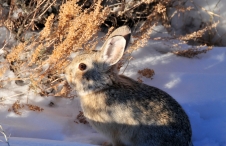Communal Antelope Drives
Pronghorn (antelope) were among the most important big game animals hunted by Nevada's indigenous people. Individuals or small groups of hunters would pursue them during the summer months. In the spring and fall, when the animals congregated into larger herds, individual families would come together for communal pronghorn drives. The drive usually required the services of an antelope shaman who directed activities and was believed to have special powers that let him "charm" the animals into a trap.
As many as 200 people might have been involved in the effort. Everyone would assist in building a new trap or refurbishing an old one. After the trap was prepared and appropriate ceremonies completed, runners were sent out to haze the animals toward the corral. Once the animals were trapped, young men kept them moving within the corral throughout the night. By the next day the pronghorn were exhausted and were easily dispatched by clubs or bows and arrows.
Pronghorn traps consisted of two parts: a roughly circular or oval corral to contain the animals, and wings that funneled the animals into the corral. Wings were usually constructed of sagebrush and could be two miles or more in length. Because pronghorn are not natural jumpers, a four foot-high wall is sufficient to contain them as long as they are not crowded or spooked. To take advantage of the non-jumping behavior, corrals were usually quite large, so as to give the animals plenty of room to move around.
The largest corral recorded in Nevada, to date, is over a third of a mile (1,900 ft.) in length. None are smaller than 600 feet. A couple of the known traps have stacked rock walls. In locations where rock and trees were scarce, sagebrush was used to construct solid walls, or it was piled in stacks that were arranged in a circular fashion. Sometimes a length of sagebrush rope was strung between the sagebrush piles.
The most common type of traps surviving today are those constructed of juniper wood. Over forty of these have been recorded in northeastern Nevada, and more are found along the Nevada-California border. Some corrals were made of juniper tree trunks laid end to end, while others incorporated upright posts and branches to form the walls.



